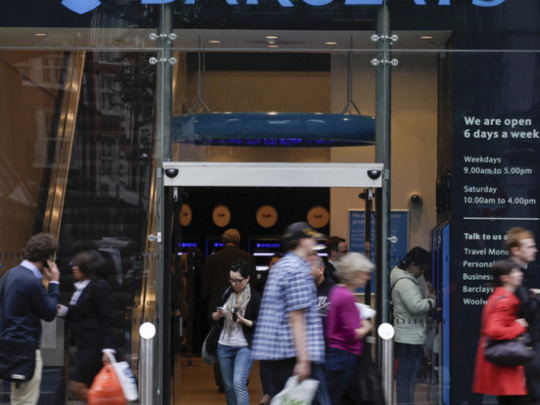
Singapore: Global banks are delaying what will be an inevitable shift to valuing unsecured derivative positions at market rates because it could hit their bottom lines, but new global prudential regulations next year are set to force their hands.
Traders and accountants have known for some time what is only becoming apparent to the public now — the London Interbank Offered Rate or Libor, the interbank funding rate now at the centre of a rigging scandal, is not the appropriate price to value most derivative deals on banks’ books.
Most banks switched to overnight-indexed-swap rates for valuing secured deals — those backed by collateral — over the past three years, after the financial crisis exposed Libor’s unsuitability as a benchmark.
Now it’s the turn of the unsecured deals, for instance swaps and options with corporate clients and institutions that traditionally don’t pledge any collateral with their bankers.
However, given rates on those transactions are significantly higher than Libor, some banks face potentially huge losses from revaluing these transactions at higher funding costs.
“In the old world, it was very simple. Everything was Libor-based,” said Yura Mahindroo, director at PricewaterhouseCoopers in Melbourne.
The 2008 crisis ended that. The credit landscape shifted radically, and the healthiest of banks have found borrowing costs can average 100 basis points over Libor. Funding costs diverge across these institutions, and the price of derivatives needs to reflect that.
“What they are starting to think about now for uncollateralised derivatives is whether they should be recording a discount rate that incorporates their own cost of funds,” said Mahindroo.
“That adjustment is most likely to be a debit and the numbers can be large, even in the hundreds of millions for the major global banks. But it’s still evolving. We haven’t seen that much take up.”
First-mover disadvantage
As of now, no one’s quite sure how entities with huge discrepancies in funding costs will arrive at a market standard for pricing unsecured trades.
FVA, or funding valuation adjustment, is a bitter pill to swallow. In the simplest terms, it means traders have to absorb the rise in borrowing costs over the past four years into the way they price a swap, pay for an option or discount future cash flows from long-term derivatives.
There is no legislative requirement to change the valuation practices for unsecured derivatives, and banks who go it alone now will price themselves out of the market.
All that’s clear is the absence of collateral makes these trades riskier, and the economic case for revised valuations is strong.
The Basel III reforms, which kick in from next year, prescribe capital requirements for unfunded deals. The amount of margin banks will have to post with their clearing agents will likewise build as interest rate swaps, currency forwards and other over-the-counter derivatives are mandatorily cleared on exchanges.
“People have realized that in adverse circumstances, the funding component becomes a major risk which has to be built into the pricing of a derivative transaction,” said the chief Asia-Pacific risk officer at a European bank.
“You have to be careful because suddenly you get collateral calls like Bear Stearns did and can no longer fund yourself, or only at excessively high prices. So the funding cost that you have to pay for collateral suddenly explodes, which has an impact on the valuation of your derivative.”
Profit boosts
It’s not a one-way street on valuations. Banks have taken advantage of valuation changes on derivatives deals to generate paper profits in recent years.
For many banks, there were paper gains to be had when accountants decided to use OIS, a risk-free rate far lower than Libor, for discounting collateralised derivatives or those that were settled on a central clearing house.
Another revenue generator in recent years was booking gains on debt valuation adjustment (DVA) -- an accounting quirk that allowed the world’s biggest banks to book handsome profits due to the reduced value of debt they had issued as their creditworthiness declined following the global crisis.
Risk managers at bank treasuries said they are making precautionary provisions for possible valuation losses this year while they wait for some form of industry consensus on unsecured derivatives to emerge by 2013.
In any case, these valuation items are lumped together as one entry in profit and loss statements, so only the net impact of revaluation will be shown.
“People are very cagey. We want to know what the others are doing,” said one risk manager at a bank in Asia. Losses at the big banks with a global presence could range from about $30 million to as much as $200 million, he said.
Differing values
Like the other components on a bank’s balance sheet, it is impossible for anyone without complete access to a bank’s derivative book to gauge the impact of these new regulatory and accounting guidelines.
“There is no bank whose funding curve is below Libor,” said Matthias Peter, a senior manager in risk consulting at KPMG in Frankfurt.
“So I would say switching from Libor to own cost of funds would have a significant impact, but, again, we cannot say whether it is a profit or loss. That depends on whether the bank has a net liability of a positive present value on the uncollateralised derivatives.”
Moreover, the switch could create a peculiar situation where two counterparties to a derivative would each value the trade differently, depending on which funding rate is applied. One party’s loss would not correspond exactly to another’s gain.
“The value of the contract in the books of each counterparty will no longer add up to zero considering the different funding situations of the two counterparties,” said the European bank risk manager.
“This could potentially create a counterintuitive situation where both counterparties could make a profit or a loss at the same time on the same contract.”












